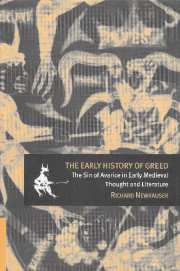Book contents
- Frontmatter
- Contents
- List of abbreviations
- Preface
- 1 Alms and ascetes, round stones and masons: avarice in the early church
- 2 Ascetic transformations I: monks and the laity in eastern Christendom
- 3 Ascetic transformations II: soaring eagles or safety in the herd – from anchoritic to cenobitic monasticism
- 4 Ascetic transformations III: the Latin West in the fourth and fifth centuries
- 5 Secularizing avarice and cupidity
- Epilogue: Future perspectives
- Appendix
- Notes
- Bibliography
- General index
- Index of names
- CAMBRIDGE STUDIES IN MEDIEVAL LITERATURE
Epilogue: Future perspectives
Published online by Cambridge University Press: 22 September 2009
- Frontmatter
- Contents
- List of abbreviations
- Preface
- 1 Alms and ascetes, round stones and masons: avarice in the early church
- 2 Ascetic transformations I: monks and the laity in eastern Christendom
- 3 Ascetic transformations II: soaring eagles or safety in the herd – from anchoritic to cenobitic monasticism
- 4 Ascetic transformations III: the Latin West in the fourth and fifth centuries
- 5 Secularizing avarice and cupidity
- Epilogue: Future perspectives
- Appendix
- Notes
- Bibliography
- General index
- Index of names
- CAMBRIDGE STUDIES IN MEDIEVAL LITERATURE
Summary
TOWARDS AVARICE IN THE MONEY ECONOMY
Continuity in the history of avarice following the inheritance of the Carolingians can be observed first of all in the relative stability of modes of analyzing the vice. The accepted norm of representing greed as either sinful acquisition or immoral retention can be observed in all major writers on the vice, as can the common equivalence of its typical designations in Latin: avaritia, cupiditas, or philargyria (filargyria). The combination of Evagrian/Cassianic and Gregorian analyses of lists of the vices and their sub-sins marked the most productive path for systematic presentations of avarice, but the foregrounding of the vice by Pirminius also remained available for homilists intent on converting their congregations from a material ideology to Christian spiritual aims. The exemplification of avarice remained stable in the period following the Carolingians, as well, with moralists drawing most often on the internal life of the clergy in attacks on the vice, their secular targets including – as earlier – the rich and merchants. Nevertheless, Alcuin's praise for commercial activity did not remain without successors; in England Ælfric (Abbot of Eynsham c. 995–c. 1012) had much to say about the essential role of merchants in his depiction of the social strata of Anglo-Saxon England.
- Type
- Chapter
- Information
- The Early History of GreedThe Sin of Avarice in Early Medieval Thought and Literature, pp. 125 - 131Publisher: Cambridge University PressPrint publication year: 2000



